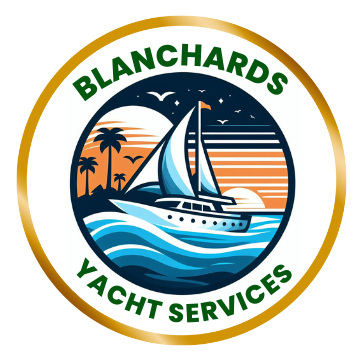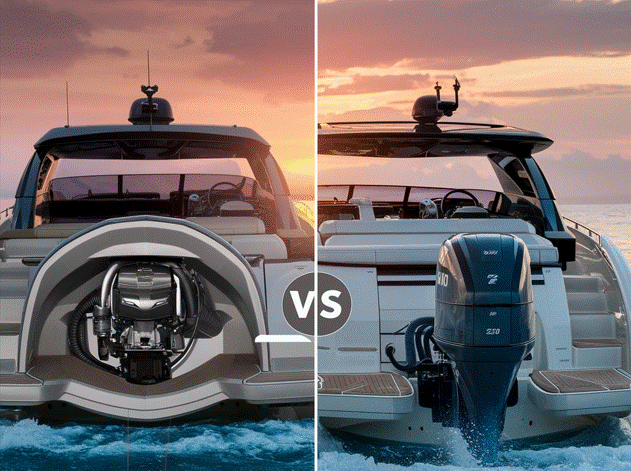When it comes to powering your Boat, the choice of propulsion system is crucial. Each option—whether inboard engines, outboard motors, or hybrid systems—offers unique advantages, and understanding these can help you make the best decision for your Vessel.
Inboard engines are the go-to for larger vessels. They sit inside the hull, which gives a balanced ride. Plus, they’re protected from the elements. You’ll usually find these engines in big boats meant for hefty jobs like towing or long journeys. Because of their placement, these engines are more powerful, too.
Some Examples of Inboard Motors:
- Caterpillar C32
Known for its exceptional power and reliability, the Caterpillar C32 is a top choice for large yachts requiring robust performance. It offers high horsepower and excellent fuel efficiency, making it ideal for long-distance cruising. - Volvo Penta D13
The Volvo Penta D13 is renowned for its smooth operation and low emissions. It’s a popular option for mid-sized yachts, combining efficiency with advanced technology, including electronic vessel control for enhanced maneuverability. - Cummins QSB6.7
The Cummins QSB6.7 is a versatile inboard engine, offering a balance of power and fuel economy. Its compact size makes it suitable for a wide range of yachts, and it’s designed for easy maintenance and long-term durability.
Outboard engines, on the other hand, are fixed outside the boat on the transom. This design makes it easier to get to the engine for maintenance. You can even tilt the engine out of the water when you aren’t using it. People love outboards for smaller boats and for situations where agility is key.
Some Examples of Outboard Motors:

- Yamaha F425 XTO Offshore
This powerful outboard motor is designed for larger vessels, offering high thrust and torque. The Yamaha F425 XTO is known for its advanced technology, including direct fuel injection and integrated electric steering, providing excellent control and efficiency. - Mercury Verado
The Mercury Verado 600 HP and Mercury Verado 400 are powerful outboard engines designed to deliver exceptional performance on the water. The Verado 600 HP is a groundbreaking V12 engine, offering unmatched torque and smooth acceleration, making it ideal for larger boats and those seeking top-tier power. On the other hand, the Verado 400, with its V8 design, provides a balance of power and efficiency, perfect for smaller vessels or those looking for reliable performance. Both engines are equipped with advanced technology for quiet operation, fuel efficiency, and a premium boating experience. - Suzuki DF350A
The Suzuki DF350A stands out for its innovative dual propeller system, which enhances stability and fuel efficiency. This motor is perfect for those seeking a powerful yet economical option for both leisure cruising and high-speed adventures.
Trying to choose between inboard and outboard engines comes down to your boat’s needs. When considering your options, think about how you’ll Use the Boat. Are you looking at Long-Distance Trips? Are you planning on towing? Or maybe you just need something nimble for short, fun outings. Your answers will guide you toward the right engine type.
Inboard Engines

Inboard engines are housed within the boat’s hull, providing a clean look and better weight distribution. They’re known for their durability and are typically more powerful, making them ideal for larger yachts that require substantial thrust. Additionally, inboard engines offer improved fuel efficiency for long-distance cruising.
Pros:
- Better weight distribution
- More powerful and efficient for long trips
- Ideal for large yachts
Cons:
- More complex maintenance
- Higher upfront costs
- Requires more space inside the hull
Outboard Motors

Outboard motors are mounted on the boat’s transom, making them easy to maintain and replace. They’re popular for smaller yachts and offer greater versatility, allowing you to tilt the engine out of the water when not in use, reducing drag and protecting the propeller.
Pros:
- Easy maintenance and replacement
- More affordable upfront
- Frees up space inside the yacht
Cons:
- Less efficient for long-distance cruising
- Typically less powerful than inboards
- Affects the yacht’s aesthetics
The Rise of Hybrid Propulsion Systems
Hybrid propulsion systems blend electric motors with traditional fuel engines. These systems are becoming popular for their eco-friendly nature and adaptability. They’re quieter, which is a big plus for anyone who enjoys serene boating. Also, hybrids excel in fuel efficiency, especially at slower speeds.
The environmental benefits of hybrids are hard to ignore. By reducing emissions and conserving fuel, they play a part in protecting our waterways. For eco-conscious boaters, this can be a major factor in the decision-making process.
One advantage of hybrid systems is their versatility. They can switch between electric and fuel power based on the situation, providing options for different boating conditions. Whether you’re cruising slowly through a no-wake zone or need extra power for open waters, a hybrid system can handle it.
Many boaters have successfully made the switch to hybrid propulsion. Their experiences show hybrids performing well in various conditions, from gentle inland lakes to more demanding marine environments. These real-world examples can be reassuring for anyone considering a hybrid setup.
Pros:
- Environmentally friendly with lower emissions
- Flexible power options
- Potential for long-term savings on fuel
Cons:
- Higher initial cost
- Complex technology requiring specialized maintenance
- Limited availability compared to traditional systems
Looking ahead, hybrid propulsion technology is only going to get better. Innovations are regularly emerging, making these systems more efficient and affordable. Keeping an eye on these advancements can help you stay ahead.
Of course, I would be remiss if I did not speak about one more very important option, and development in the world of engine motors.
Electric Motor

Electric motors are revolutionizing the yachting industry by offering a clean, quiet, and efficient alternative to traditional fuel-powered engines. These motors run on electricity stored in batteries, which can be recharged through various means, such as shore power, solar panels, or regenerative systems. The primary advantages of electric motors include zero emissions, minimal noise, and lower maintenance costs, making them an ideal choice for eco-conscious yacht owners. They are especially suited for cruising in environmentally sensitive areas where reducing the impact on marine life is crucial.
While historically limited by range and battery capacity, recent advancements in lithium-ion battery technology have significantly extended the range and performance of electric motos, making them more practical for longer voyages.
Several companies are leading the charge in developing cutting-edge electric propulsion systems for vessels. Torqeedo, a German company, is a pioneer in this field, offering a wide range of electric outboard and inboard motors that are known for their reliability and efficiency. Oceanvolt, based in Finland, is another key player, specializing in hybrid and electric propulsion systems with a focus on regenerative energy and sustainability. Electric Yacht is a U.S.-based company that provides electric motors specifically designed for sailboats, offering easy installation and integration with existing systems.
These companies are at the forefront of the electric propulsion movement, driving innovation and helping to make yachting a more sustainable and environmentally friendly activity.
? Ready to Soar? Take your travel game to the next level with VOYAFLY! ? Get Unlimited Roaming Data eSIMs across 150 Countries. ✈️ Don’t miss out—visit VOYAFLY today and get connected! ✈️?

What is the Most Efficient Boat Propulsion System?
When evaluating the efficiency of a boat propulsion system, it’s important to consider not only fuel consumption but also the overall performance, maintenance requirements, and environmental impact. Hybrid propulsion systems are often regarded as the most efficient in today’s market. As we mentioned before, by combining traditional internal combustion engines with electric motors, hybrids offer the flexibility to use electric power for low-speed cruising and switch to conventional engines for higher speeds or when more power is needed. This dual-mode capability reduces fuel consumption, lowers emissions, and offers significant cost savings over time, especially for frequent or long-distance cruisers.
On the other hand, inboard engines are known for their efficiency in delivering consistent power and performance, particularly for larger yachts that undertake long voyages. These engines are optimized for fuel efficiency during continuous operation, making them ideal for extensive cruising without frequent stops. However, while inboard engines are efficient in terms of power output relative to fuel use, they might not match the environmental efficiency of hybrid systems. Ultimately, the most efficient propulsion system depends on the yacht’s usage patterns, with hybrids leading the way for those seeking a balance of eco-friendliness and performance.
Conclusion
When choosing a propulsion system, consider what’s most important to you. Whether it’s raw power, easy upkeep, or sustainability, knowing your priorities will help you decide between inboard, outboard, or hybrid options. Each has its strengths, so think about how they match your boating lifestyle.
**Our Website contains affiliate links. This means if you click and make a purchase, we may receive a small commission. Don’t worry, there is no extra cost to you. It’s a simple way you can support our mission to bring you quality content**.

